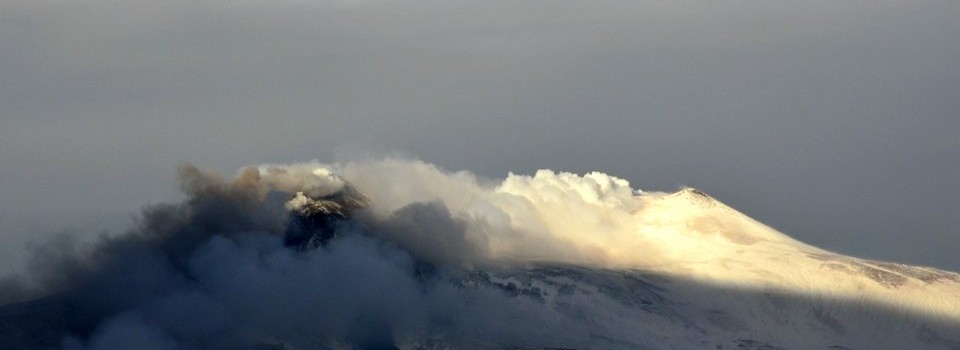 Durante il mese di gennaio 2016, l'attività eruttiva dell'Etna si è mantenuta su livelli molto bassi. All'inizio del mese, si sono osservate alcune deboli emissioni di cenere dalla bocca del 25 novembre 2015 sull'alto fianco orientale del cono del Nuovo Cratere di Sud-Est (NSEC); tale fenomeno si è ripetuto negli ultimi giorni di gennaio e ancora una volta nella mattinata del 6 febbraio. Nello stesso periodo, le emissioni di gas dal Cratere di Nord-Est (NEC) hanno più volte contenuto piccole tracce di cenere.
Durante il mese di gennaio 2016, l'attività eruttiva dell'Etna si è mantenuta su livelli molto bassi. All'inizio del mese, si sono osservate alcune deboli emissioni di cenere dalla bocca del 25 novembre 2015 sull'alto fianco orientale del cono del Nuovo Cratere di Sud-Est (NSEC); tale fenomeno si è ripetuto negli ultimi giorni di gennaio e ancora una volta nella mattinata del 6 febbraio. Nello stesso periodo, le emissioni di gas dal Cratere di Nord-Est (NEC) hanno più volte contenuto piccole tracce di cenere.
Durante un sopralluogo effettuato da personale INGV-Osservatorio Etneo (INGV-OE) il 19 febbraio 2016 in area sommitale, non si è osservata alcuna emissione di cenere. Il NEC era sede di un intenso degassamento dal suo condotto aperto ma a causa del vento forte non era possibile constatare se ci fossero boati udibili provenienti da questo cratere. Agli altri crateri, l'attività di degassamento era limitata ad estese zone fumaroliche in corrispondenza degli orli craterici. I prodotti eruttivi di dicembre 2015 che riempiono l'interno della grande, unica depressione costituita dalla Voragine e dalla Bocca Nuova, erano ricoperti da neve tranne nelle zone di fratture apertesi per la compattazione del deposito e sede di emissioni di vapore.
 Alle ore 03:22 UTC (=ore locali -1) del 23 febbraio 2016, i sistemi di sorveglianza visiva e termica dell'INGV-OE hanno registrato un evento esplosivo al NEC, che ha lanciato materiale piroclastico incandescente fino a qualche decina di metri sopra l'orlo craterico (vedi immagine in alto a sinistra, registrato dalla telecamera visiva ad alta definizione a Monte Cagliato, sul fianco orientale dell'Etna - clicca sull'immagine per ingrandire) e prodotto un pennacchio di cenere scura che è stato spinto dal forte vento verso nord-est. Le immagini al centro a sinistra (clicca sull'immagine per ingrandire), riprese dalla telecamera ad alta sensibilità sulla Montagnola (EMOH, sull'alto fianco sud dell'Etna) mostrano inoltre alcune piccole scariche elettriche nella nube di cenere.
Alle ore 03:22 UTC (=ore locali -1) del 23 febbraio 2016, i sistemi di sorveglianza visiva e termica dell'INGV-OE hanno registrato un evento esplosivo al NEC, che ha lanciato materiale piroclastico incandescente fino a qualche decina di metri sopra l'orlo craterico (vedi immagine in alto a sinistra, registrato dalla telecamera visiva ad alta definizione a Monte Cagliato, sul fianco orientale dell'Etna - clicca sull'immagine per ingrandire) e prodotto un pennacchio di cenere scura che è stato spinto dal forte vento verso nord-est. Le immagini al centro a sinistra (clicca sull'immagine per ingrandire), riprese dalla telecamera ad alta sensibilità sulla Montagnola (EMOH, sull'alto fianco sud dell'Etna) mostrano inoltre alcune piccole scariche elettriche nella nube di cenere.
 Nelle immagini della telecamera termica a monte Cagliato (EMCT, vedi immagini in basso a sinistra - clicca sull'immagine per ingrandire), l'esplosione ha generato una forte anomalia ed è stata seguita da minori emissioni di cenere che sono gradualmente diminuite; nella mattinata del 23 febbraio, intermittenti e deboli emissioni di cenere stanno continuando al NEC.
Nelle immagini della telecamera termica a monte Cagliato (EMCT, vedi immagini in basso a sinistra - clicca sull'immagine per ingrandire), l'esplosione ha generato una forte anomalia ed è stata seguita da minori emissioni di cenere che sono gradualmente diminuite; nella mattinata del 23 febbraio, intermittenti e deboli emissioni di cenere stanno continuando al NEC.
ETNA UPDATE, 23 FEBRUARY 2016
During the month of January 2016, Etna's eruptive activity has maintained rather low levels. Early that month, a few weak ash emissions occurred from the 25 November 2015 vent located high on the eastern flank of the New Southeast Crater (NSEC) cone; similar phenomena were repeated during the last week of January and once more on the morning of 6 February. During the same time interval, degassing from the Northeast Crater (NEC) were sometimes accompanied by the emission of minor traces of ash.
A field survey was carried out in Etna's summit area by INGV-Osservatorio Etneo (INGV-OE) staff on 19 February. During the visit, no ash emissions occurred from the summit craters, but the NEC was the site of intense degassing from its open conduit; due to strong wind it was not possible to hear if there was any acoustic activity coming from the crater, which typically produces loud bangs and rumblings. At the other summit craters, degassing was limited to extensive fumarolic areas along the crater rims. The eruptive products of december 2015, which fill the single huge depression constituted by the Voragine and Bocca Nuova, were covered with snow except in the areas where vapors were emitted from fissures formed by compaction of the deposit.
At 03:22 UTC (=local time -1) on 23 February 2016, the video and thermal cameras of the INGV-OE recorded an explosive event at the NEC, which ejected incandescent pyroclastics to several tens of meters above the crater rim (see image at top left, recorded by the high-definition visual camera at Monte Cagliato, on the east flank of Etna - click on image for larger version) and produced a dark ash plume that was blown northeastward by strong wind. The images at center left (click on image for larger version) were recorded by the high-sensitivity camera on the Montagnola (EMOH, on the upper south flank of Etna) and also show a few lightning flashes in the ash cloud.
The images recorded by the thermal surveillance camera at Monte Cagliato (EMCT, see images at bottom left - click on image for larger version) show a conspicuous anomaly generated by the explosion, which was followed by minor ash emissions that gradually diminished; as of the late morning of 23 February, intermittent and weak ash emissions are continuing from the NEC.









 Dall'inizio della giornata le stazioni della Rete Sismica hanno registrato uno sciame sismico nel medio-alto versante nord-orientale dell'Etna. sino alle ore 12:45 locali, sono state registrate 46 scosse sismiche, la maggior parte di queste avvertibili solo a livello strumentale.
Dall'inizio della giornata le stazioni della Rete Sismica hanno registrato uno sciame sismico nel medio-alto versante nord-orientale dell'Etna. sino alle ore 12:45 locali, sono state registrate 46 scosse sismiche, la maggior parte di queste avvertibili solo a livello strumentale.
 After the four paroxysmal eruptive episodes at the Voragine crater of Etna in the past few days, the focus of eruptive activity has shifted, in the early hours of 6 December 2015, to the New Southeast Crater (NSEC), activating the pit crater that had formed around 25 November on the upper east flank of the NSEC cone (see photo at upper left, recorded by the visible monitoring camera EMOV of the INGV-Osservatorio Etneo on the Montagnola).
After the four paroxysmal eruptive episodes at the Voragine crater of Etna in the past few days, the focus of eruptive activity has shifted, in the early hours of 6 December 2015, to the New Southeast Crater (NSEC), activating the pit crater that had formed around 25 November on the upper east flank of the NSEC cone (see photo at upper left, recorded by the visible monitoring camera EMOV of the INGV-Osservatorio Etneo on the Montagnola).